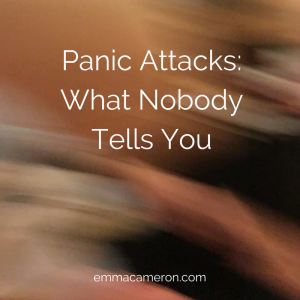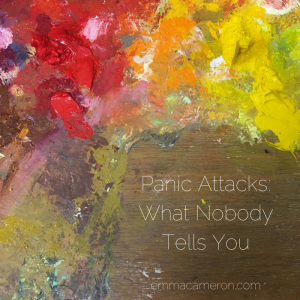Panic attacks – as you’ll know, if you’ve ever suffered one – can be very unpleasant.
Panic attacks: horrible experiences. Symptoms can be slightly different for everyone, but may include:
- Feeling like you’re about to die
- Feeling trapped
- Difficulty breathing
- Feeling of adrenalin rushing through your body
- Dry mouth
- Nausea
- Feeling of irregular or rapid heartbeat
- Shakiness
- Sweating
- Dizziness
- Feeling ‘spacey’ or disorientated
- Tight throat
In other words: panic attacks involve LOTS of difficult and intense feelings.
So it makes sense that you might assume that in order to avoid further panic attacks, the answer is to try and have fewer feelings.
Does everybody (including your own inner voice) tell you to feel less, shut down the feelings, stop being so affected by your feelings?
Maybe we need to turn this idea around.
Surprisingly, what might help you, if you’ve been suffering from panic attacks, could be NOT to try and reduce, shut down, hide or avoid your feelings.
What could help?
Perhaps nobody has told you before, but here are the two important things that (over time) can really transform your experience:
-
Feel more (!)
-
Develop a different relationship with your feelings
Let’s unpack that a little, because it might sound a bit counter-intuitive…
(And please note that this blog post is aimed at persons who do not have a history of psychiatric disorder, trauma, or psychosis. If you are in any doubt, or have a diagnosed mental health condition, please consult with your doctor about what is appropriate for your individual needs. The suggestions below are only suggestions and ideas, and not directives or medical advice.)
1. Feel more
‘Feel more!!!?????’ you’re probably saying. ‘Are you crazy? I already feel way more than I want to!’
Hear me out.
I’m not saying you need to feel more of the terror, dizziness, and all of those other panicky feelings.
But one reason difficult feelings may build up into extreme panic levels could be because your inner feelings-sensing mechanism has become a bit too rusty and clunky.
It’s as if you were trying to paint a beautiful Autumnal landscape of rolling wooded hills, fields and distant sea, but your paintbox only has chunky primary colour marker pens, that won’t mix and can’t be modulated into different levels of intensity.
So you’ve got a range of colours, but they are quite strong, intense and basic.
Which kind-of works. But you miss out on a lot.
You feel the extremes, but not the subtleties and the interesting ‘in-betweens’.
You can’t explore what it might be like if you were to mix lemon yellow and cadmium red and titanium white and a tiny little bit of violet.
You can’t discover what happens when you put this raw umber next to this shade of crimson.
You can’t know that this ultramarine blue mixed with this cobalt blue reminds you of a crisp October sky when you add just the right amount of water to dilute the colour.
So, if we get back to the theme of panic attacks: You might be (as it were) using your Blue marker pen most of the time, and feeling okay; but then a triggering situation comes into view.
Suddenly, it’s: Forget that calm Blue! And you’re plunged into a somewhat alarmed Yellow (like, “What if I have to go to that place, with that person, and I feel panicky, and I can’t get out?”).
And if the panicky feelings rise, you’re quickly into a high-fear, high-alert Red. You feel that a panic attack might be imminent.
The feelings, like those marker pens, lack subtlety, flexibility and range.
So what’s needed is to feel more; to discover your feelings in new ways.
Here are some examples of what that could look like:
- To find the nuances of your feelings
- To notice how they change from moment to moment
- To learn how to modulate the intensity of your feelings
- To wonder about your feelings
- To let them flow when it’s appropriate
- To learn how to hold your feelings gently and securely until you’re in a safe place to let them flow
- To learn how not to be taken hostage by your feelings
- To find where in your body a feeling is held, and also to connect better to parts of your body that feel more grounded and less overwhelmed
- To stop numbing and zoning out as often
- To discover a rich and wide vocabulary of words for feelings, to help you make sense of your emotions and become much more able to express them to others, so that people understand you better
- To become ‘at home with your feelings’ so that they don’t frighten you
- To let your feelings give meaning and direction to your life in a way that’s in line with your true values
- To feel, but to become able at the same time to use your thinking brain, the part that knows that a panic attack does NOT mean you are in danger, or having a heart attack
“Sounds great, but… How do I actually do that?”
Yes, there can be quite a learning curve.
You’ve likely spent your whole life so far, developing a habit of shutting off from your emotional experience (and there’s no blame or shame here, because there will somewhere be good reasons for this, even if you don’t know what they are).
So. How to get better at tuning in to your feelings, including all the subtle ones, the vague and fuzzy ones, the tearful ones, the complicated ones, and even the ones you think you ‘shouldn’t’ feel??
There are a few things you can try.
- Be willing to tune in to your feelings ongoingly as they emerge in your body.
- Say to yourself, “All feelings are welcome” – and mean it.
- Get involved in body-and-soul activities such as gardening, being with horses, yoga, meditation, creating art, dancing, singing, and spending time in nature.
- Find a therapist who ‘gets you’ and work with him/her for a while.
- And of course (this is very important), to consult with a doctor who can check out your physical health and rule out any medical problems that might need attention.
Working with a therapist can be incredibly helpful.
Generally speaking, panic attacks don’t just ‘happen’ to people randomly. There may be some kind of traumatic experience or anxiety history that needs to be processed. It can be difficult (or even impossible) to do this without some expert help from a counsellor or therapist.
Therapy is all about finding ways to connect with your feelings in ways that feel safe, and discovering how to tune in to your subtle feelings as well as the big ones.
In therapy, as your relationship with your therapist builds in trust, it becomes safer and more possible to feel the full range of your feelings.
The therapist is there with you, to help you manage the feelings.
And your new-found ‘feelings skills’ will gradually extend into your everyday life (so don’t worry, you won’t be forever dependent on having your therapist alongside you!)
As well as helping you feel a fuller range of feelings, and sometimes modulate their intensity, therapy also helps you develop a different relationship with your feelings.
Which brings us to point 2.
2. Develop a different relationship with your feelings
The thing is, with feelings, we can’t just make them disappear and not exist (you’ve certainly tried to do that, and how well did that work?)
Feelings don’t just vanish (not for very long, at least).
Our brains and bodies are made to experience feelings. We can push them down, and tell ourselves we don’t feel them, but unfortunately there is always a big price to pay for this repression.
And avoiding feelings doesn’t work too well either.
Trying to avoid situations that might trigger a panic attack, just means your life gets more and more limited and restricted.
So what can you do?
You can develop a different way of relating to your feelings.
So that all the feelings and thoughts you have, stop seeming to be ‘who I am’ and instead can be seen as ‘something I sometimes experience’ – with you managing to hold on to a sense of ‘I’ as being greater than your feelings and thoughts, and not controlled by or immersed in them.
Think of it this way:
Here’s a metaphor: Imagine a sheet of paper (which represents your feelings) that can’t be removed from you or destroyed.
You could hold the paper tightly right in front of your face. But that blocks your view of things and interrupts with all the things you’d like to do, and the connections with people that you’d like to make.
Or you can learn to rest the paper on your lap instead, so that you are free to view and experience your feelings, but also to see the world, and other people, more freely and realistically.
“Sounds great, but… How do I actually do that?”
Here’s where mindfulness comes in.
Mindfulness can help us to be present, to develop a really different relationship with our feelings and thoughts, and to feel a sense of inner emotional space and acceptance.
I’ll be writing more about mindfulness in coming blog posts, but you also can find out more about it in articles online, books, apps, and on YouTube.
And again, working on mindfulness with a therapist or mindfulness teacher can be very helpful.
(Important Note: If you have experienced trauma, or have suffered psychosis or another psychiatric disorder, check with your doctor first. For people with trauma or severe mental health conditions, mindfulness should be approached with caution, and preferably as part of an ongoing psychotherapy treatment, because for some people there is a risk of some mindfulness meditation practices triggering symptoms).
Panic Attacks: What nobody tells you Share on XSo, to recap: What nobody tells you about panic attacks, is this:
It’s not about feeling too much. It’s more about not feeling enough, and also about developing a different way of relating to your feelings.
I hope I’ve sparked your curiosity about building different ways of helping yourself feel much less at the mercy of those scary panic-attack-type feelings.
If you’d also like some practical tools that you can use to help you with panic attacks, it’s here.
Help for creative women who suffer panic attacks. #Essex #Suffolk and #online Share on XAnd if you’d like some support as you work on anxiety issues, and develop more richness and depth in your experience of your feelings, you may like to work with me in personal therapy. I work with creative, thoughtful women in Integrative Arts Psychotherapy near Colchester, Essex, and I also offer online counselling for anxiety issues.



